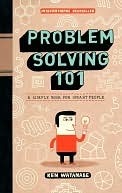More on this book
Community
Kindle Notes & Highlights
by
Ken Watanabe
Read between
August 21 - September 7, 2019
they think about the root causes of their problems and map out an effective plan before and while taking action, and they are willing to rework their plan as new challenges pop up. By striking a balance between thinking and acting, they can accomplish amazing things. Problem-solving kids enjoy learning from their successes as well as from their failures. The tool kit of a problem-solving kid includes identifying the root cause of a problem and setting specific goals. They have positive attitudes and stay focused on what can be changed rather than what already happened. They come up with
...more
Problem solving isn’t a talent that some people have and others don’t. It’s a habit. By developing the right skills and adopting the right attitude, anyone can become a problem-solving kid.
When you do take action, every result is an opportunity to reflect and learn valuable lessons. Even if what you take away from your assessment seems to be of small consequence, all of these small improvements taken together make a huge difference in the long term.
Problem solving is a process that can be broken down into four steps: (1) understand the current situation; (2) identify the root cause of the problem; (3) develop an effective action plan; and (4) execute until the problem is solved, making modifications as necessary.
All you have to do is understand the situation, identify the root cause, develop an effective plan, and execute. Even if the problem you face is big and complicated, if you learn how to break it down into smaller, manageable problems, you will be able to solve it.
Once you learn the basic problem-solving approach, you can stop panicking and gain the confidence to solve any problems that you face in life, whether they are about grades, work, or your personal life.
A logic tree is a great tool to use when you problem solve. It’s a visual tool that helps when you are trying to identify all the potential root causes of a problem and generate a wide variety of solutions. The key to making a useful logic tree is to break down a problem into categories without leaving anything out, and to group similar items under the same branch.
In the design plan, you clarify the issues you are trying to solve, state your current hypotheses and rationale, and list the analyses, actions, and information required to prove or disprove those hypotheses.
They probably would have put up posters and distributed flyers all over the school and ended up increasing the number of spectators by a marginal amount. (Because no matter how much they raised awareness, only 10 percent of the people who knew about the show would likely come.) This is why you should test your hypothesis if you can figure out an efficient way to do so.
You may think she was just lucky, but this all happened because she challenged her own preconceptions, because she proactively took action, and because she not only had a talent for soccer but practiced hard over the years to develop her skills.
Spend less time worrying about things and more time thinking about actions you can take to get closer to your goals, then actually take action.


